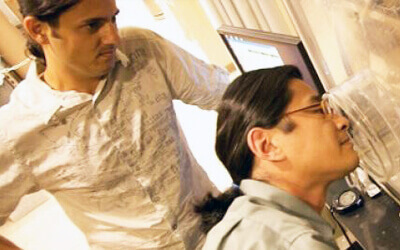
Inflation of a balloon catheter with integrated liquid metal-based stretchable electronics
Most medical electronics are built on rigid platforms – a poor match for the soft, dynamic tissues of the human body. This mismatch can reduce effectiveness of treatment, cause discomfort and even damage tissue.
Zhao Research Group, led by Hangbo Zhao, assistant professor of aerospace and mechanical engineering and biomedical engineering, specializes in mechanics-driven manufacturing processes to create stretchable materials and electronics for applications in biomedical engineering and soft robotics.
The group’s latest paper in Science Advances, titled “High-resolution liquid metal-based stretchable electronics enabled by colloidal self-assembly and micro-transfer printing,” was produced in collaboration with researchers at Northwestern University and the University of Chicago. The paper outlines the process of fabricating liquid metal-based electronics that are highly stretchable and patterned with micrometer-scale precision.
Printing liquid metal electronics
Liquid metals are an attractive basis for flexible electronics because they deform easily – the process of changing shape or size when subjected to external forces while also conducting electricity efficiently.
However, it is notoriously difficult to create devices that are both finely patterned and scalable. Existing fabrication approaches often require a trade-off between resolution and manufacturability.
“What makes this research truly innovative is the novel combination of colloidal self-assembly and microtransfer printing,” Zhao explained. “This lets us ‘print’ liquid metal particles with extraordinary resolution – down to a few micrometers, about the size of a human red blood cell – while remaining stretchable by more than 1,200%. Even more remarkably, these electronics deliver consistent performance regardless of how much they are bent, stretched or pressed.”
High-performance prototypes
To illustrate the potential of their approach, the team built and tested two prototypes: soft strain sensors and instrumented balloon catheters.
Soft strain sensors are capable of accurately measuring large deformations. Unlike many existing sensors, these remain reliable under extreme stretching, suggesting uses in wearable technologies, motion tracking or soft robotics.
When inflated inside the heart, balloon catheters with liquid metal microelectrode arrays expand without compromising electrical conductivity. In laboratory and animal tests, they provided high-resolution maps of cardiac electrical activity and maintained low impedance, offering more detailed data than conventional catheters.
“These examples illustrate how our approach can outperform current rigid, low-resolution devices and move medicine closer to precision tools that conform seamlessly to the body,” said Zhao.
From engineering equations to human hearts
The study involved bridging the gap between engineering and medicine. “To prove that our devices worked in real-world conditions, we had to carry out extensive animal studies and tests in both living and explanted hearts – which required very close collaboration with clinical collaborators at Northwestern University and the University of Chicago,” said Zhao.
Zhao Research group led the development of the materials and fabrication methods, and ultimately built the devices. Throughout the process, they worked closely with Professor Igor Efimov, an expert in cardiology at Northwestern University. Discussions with Efimov shaped the direction of the biomedical applications, such as applying stretchable electronics to expandable tools like balloon catheters.
Efimov’s team, including Assistant Professor Anna Pfenniger at Northwestern and Professor Rishi Arora at the University of Chicago, carried out the in vivo and ex vivo studies. Their expertise was essential in testing the devices in realistic cardiac settings – from animal models to explanted human hearts.
Another challenge was developing a deep understanding of the process physics in the liquid metal electronics. “We wanted not only to demonstrate that these materials and devices work, but also to understand why and how they work, said Zhao. “To achieve this, we carried out detailed analytical and experimental studies to uncover the underlying mechanisms behind their behavior.”
The future is stretchable
While cardiac mapping provided a strong test case, the implications extend more broadly. High-resolution, stretchable electronics could support devices including implantable biomedical sensors for long-term monitoring of physiological signals, and wearable health monitors that maintain accuracy during movement.
“Ultimately, our goal is to improve patient care and enable the next generation of human–machine interfaces that feel natural and biocompatible,” said Zhao.
Read the paper in full here.
Published on September 29th, 2025
Last updated on September 29th, 2025







